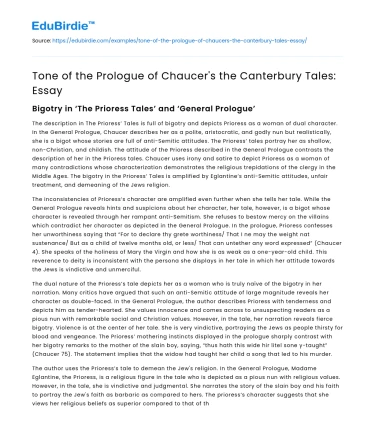Bigotry in ‘The Prioress Tales’ and ‘General Prologue’
The description in The Prioress’ Tales is full of bigotry and depicts Prioress as a woman of dual character. In the General Prologue, Chaucer describes her as a polite, aristocratic, and godly nun but realistically, she is a bigot whose stories are full of anti-Semitic attitudes. The Prioress’ tales portray her as shallow, non-Christian, and childish. The attitude of the Prioress described in the General Prologue contrasts the description of her in the Prioress tales. Chaucer uses irony and satire to depict Prioress as a woman of many contradictions whose characterization demonstrates the religious trepidations of the clergy in the Middle Ages. The bigotry in the Prioress’ Tales is amplified by Eglantine’s anti-Semitic attitudes, unfair treatment, and demeaning of the Jews religion.
The inconsistencies of Prioress’s character are amplified even further when she tells her tale. While the General Prologue reveals hints and suspicions about her character, her tale, however, is a bigot whose character is revealed through her rampant anti-Semitism. She refuses to bestow mercy on the villains which contradict her character as depicted in the General Prologue. In the prologue, Prioress confesses her unworthiness saying that “For to declare thy grete worthiness/ That I ne may the weight nat sustenance/ But as a child of twelve months old, or less/ That can untether any word expressed” (Chaucer 4). She speaks of the holiness of Mary the Virgin and how she is as weak as a one-year-old child. This reverence to deity is inconsistent with the persona she displays in her tale in which her attitude towards the Jews is vindictive and unmerciful.
Save your time!
We can take care of your essay
- Proper editing and formatting
- Free revision, title page, and bibliography
- Flexible prices and money-back guarantee
The dual nature of the Prioress’s tale depicts her as a woman who is truly naïve of the bigotry in her narration. Many critics have argued that such an anti-Semitic attitude of large magnitude reveals her character as double-faced. In the General Prologue, the author describes Prioress with tenderness and depicts him as tender-hearted. She values innocence and comes across to unsuspecting readers as a pious nun with remarkable social and Christian values. However, in the tale, her narration reveals fierce bigotry. Violence is at the center of her tale. She is very vindictive, portraying the Jews as people thirsty for blood and vengeance. The Prioress’ mothering instincts displayed in the prologue sharply contrast with her bigotry remarks to the mother of the slain boy, saying, “thus hath this wide hir litel sone y-taught” (Chaucer 75). The statement implies that the widow had taught her child a song that led to his murder.
The author uses the Prioress’s tale to demean the Jew's religion. In the General Prologue, Madame Eglantine, the Prioress, is a religious figure in the tale who is depicted as a pious nun with religious values. However, in the tale, she is vindictive and judgmental. She narrates the story of the slain boy and his faith to portray the Jew's faith as barbaric as compared to hers. The prioress’s character suggests that she views her religious beliefs as superior compared to that of the Jews. The Prioress’ name itself symbolizes the Virgin Mary as the author states that “She was cleped madame Eglentyne,” (Chaucer 121). While her name was supposed to be an embodiment of love and mercy, her character is the exact opposite. The Prioress holds her religious beliefs as supreme over that of the Jews. Contrary to this notion, mercy and love are major elements that she lacks in her character. This is demonstrated by the unspeakable treatment and vengeance that is meted on the Jews after killing the boy.
The Prioress is unreasonably harsher on the Jews than was the custom of the period. This contradicts the author’s description of her in the General Prologue which depicts her as a pious nun. She is described as an attractive and aristocratic lady with a persona that is worthy to be emulated by other pilgrims. Chaucer states that “Hir greatest tooth was but by Seynte Loy,” (Chaucer 121) implying that she had an unwavering devotion to religion. On the contrary, the glaring and obvious part of her tale is the anti-Semitic views. Her bigotry views, which come out throughout her tale as observed by the readers, show that she is more bigoted that any average peasant of the Middle Ages. She refuses to give mercy to the villains in her narration which portrays a different woman than the one introduced in the General Prologue. She is not authentic and the Chaucer describes her as a “counterfeit” (p. 140) who acts exactly opposite to what she claims to be.
In conclusion, the Prioress’ bigotry is brought out by the shallow, immature, ungodly, and vindictive character that she portrays in her tale. Her description in the General Prologue differs contrastingly from her actual behavior in her tales. Her narration is not only full of anti-Semitic attitudes, but she also inflicts violence and vengeance as well as unfair treatment of the Jews. She judges the Jews harshly and portrays their religion as inferior compared to her own. The portrayal of the Prioress as a woman of many paradoxes serves to show the readers about the religious trepidations of the Middle Ages.
Works Cited
- Chaucer, Geoffrey. The Canterbury tales. Broadview Press, 2012.






 Stuck on your essay?
Stuck on your essay?

